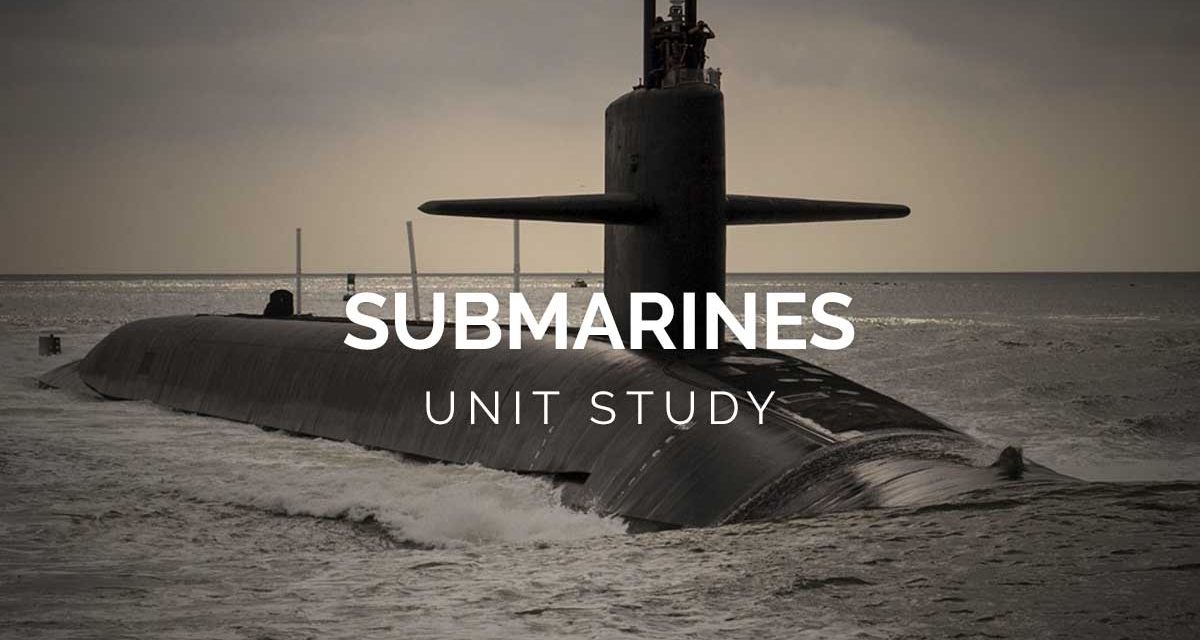“Till my soul is full of longing for the secret of the sea, and the heart of the great ocean sends a thrilling pulse through me.”
— Henry Wadsworth Longfellow
Understanding the secrets of the sea has driven inventors, explorers and military minds to create and improve the unimaginable. Encourage your children to close their eyes and visualize this: An enclosed vessel submerged in water… one that may remind you of a large tin can. There are no windows, and with the right balance of air or water, you can sink deep under water and move about silently, much like a whale. It sounds like science fiction, doesn’t it? Remarkably, amid development of submersibles for man’s use, Jules Verne published his popular science fiction novel 20,000 Leagues Under the Sea in 1870.
April 11th celebrates the ingenuity of a great military and scientific vessel – the submarine. Welcome to this month’s unit study, dedicated to National Submarine Day! In our study this month, we will look at the history of submarines, life on a submarine, how submarines work, and much more. There are numerous links in our study, and many of the YouTube links are lengthy (25-30 minutes). I would encourage you to set aside a 3-4 hour block of time for this month’s study. Let’s dive in!
On April 11 in 1900, the first naval submarine, the USS Holland, was commissioned. However, this was not the first instance of a submarine being used by the military – or man in general. The origin of the submarine dates back to 332 BC with Alexander the Great’s glass diving bell. Legend has it that the glass-encased bell allowed him to be submersed for long periods to observe marine life and was also used by soldiers to destroy underwater defenses. While relatively simplistic, the diving bell is said to have been the inspiration for future submarine development. It is believed that the Dutchman Cornelius van Drebbel developed the first working submarine, which was an enclosed rowboat manned by twelve oarsmen. The American Revolutionary War presented the first opportunity for a submarine to be used by military forces. Aptly named the Turtle, this one-man submarine had the appearance of two turtle shells lying face to face. The mission of the Turtle was considered a failure and submarine use was stalled for a number of years. Families interested in the history of submarines and submarine warfare will enjoy Submarine-the History of Submarine War and this fascinating view of the USS Pennsylvania, the largest submarine in the U.S. Navy.
Hopefully your child’s curiosity is kindled for understanding how a submarine works. Like other ships, submarines float because the weight of the water it displaced is equal to the weight of the ship. Setting the submarine apart from other ships is the ability to control buoyancy. Learn about buoyancy and the submarine. How Submarines Work, U-505 Buoyancy and Submarines for Preschool and Kindergarten, all provide excellent explanations for understanding buoyancy. Let children experiment with buoyancy and make a submarine that floats and sinks. Inspire them with this fascinating interview with 18-year-old Justin Beckerman, who created his own 1-person submarine.
At the beginning of our study, children were asked to imagine the interior of a submarine. Trying to describe life inside of a submarine is difficult, much like trying to explain the color blue! As a family, explore life inside a submarine. Some families may be able to visit a submarine museum. If this is not an option, CNN offers a first-hand look at life aboard the USS Missouri and the BBC’s Life on Board the HMS Triumph gives us a glimpse at daily life in the Royal Navy. You can also take an interactive tour of the USS Albacore. Encourage older children to compare and contrast the military submarines shown in the videos. Before we leave the idea of military life on a submarine, I wanted to take a moment to reflect upon the life of a submariner. Living several hundred feet below sea level for months on end, the submariner’s motto often reflects the idea that “all come to the surface or no one does.” On a submarine, the phrase “all for one and one for all” is not just a catchphrase but reality. Philippians 2:3-4 states “Do nothing out of selfish ambition or vain conceit. Rather, in humility value others above yourselves, not looking to your own interests but each of you to the interests of the others.” Ask your children how this verse applies to the lives of submariners. Follow this up by asking them “How are you able to live out this verse today? Do you often take into account the interests of your siblings? Are you willing to put the needs of your siblings above your own?” Living underwater in tight quarters with the same people for days or months at a time gives one ample practice in getting along and putting the needs of others first. What better way to live like a submariner than by putting into practice this motto at home! Additional verses that build on this principle include: Ephesians 4:32; Matthew 20:28; Romans 12:18 and Proverbs 19:11. Read and discuss these as a family.
While today’s submarines are widely used for military purposes, they do have other applications, including ocean floor explorations and marine life studies. Opening up the world of marine biology is fascinating for all ages, whether they are eager to view the creatures found in the cold, dark depths of the sea or to explore the wreckage of the Titanic. Encourage children to take part in marine explorations through NOAA’s My Submarine and Ocean Explorer.
Alas, Jules Verne said it best “thus ends the voyage under the seas.” It is my hope this study has inspired your family’s appreciation for the men and women, who comb the depths of the sea, to gain understanding, national protection and ultimately to the greater benefit of mankind. Until next time, take time to deeply explore and learn as a family!





